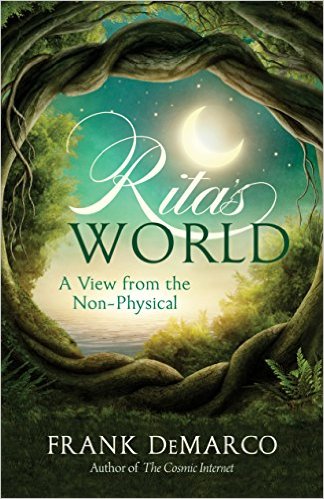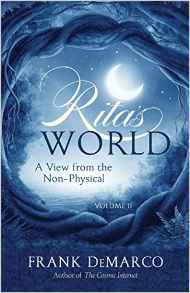



Rita’s World:
A View from the Non-Physical
By
Frank DeMarco
Reviewed by Henry Reed
Boundaries are dissolving everywhere, leaving us in a sea of relationships
without any apparent paddle to use to define ourselves in a customary manner.
The loss of boundaries is my particular perspective on current events as they
pertain to the current stage in the evolution of consciousness. The permeability
of our national borders, the ease with which private emails can be made public,
the contamination of farmer’s crops by the spread of genetically modified
material, bacteria that are resistant to our control and so spread universally,
and I could go on and on. One particular area where the boundary is falling is
between life and death, the physical and the metaphysical, or consciousness and
matter. I’m not merely referring to medical life support systems that can keep a
person otherwise dead technically alive forever. I’m thinking more about the
dissolving of the boundary between people who are alive in the body and people
who have “passed on” and are alive in spirit. Mediumship, or generally
conversations between the “living” and the “dead” is at an all time high. I’ve
reported on several books by mediums who are bringing us messages from those we
assume to be non-functional. One of the great gifts that this dissolving
boundary brings us is help in better understanding consciousness and its
existence outside of three-dimensional reality.
Moving into the realm of consciousness itself presents challenges to our
sensory, three-dimensional mind. We continually borrow from our three
dimensional experience to create metaphors for events in consciousness. We speak
of “higher” consciousness, based upon our perspective from mountain tops and
airplanes, and we look “up” to communicate with spiritual beings. We astral
“travel” from one place to another, or “remotely” view those places. We “open
up” to spiritual awareness, but, being reminded of the downside of open windows
and the value of having screens in place, we “surround ourselves” with light so
no cooties will be able to enter our meditation. And when we die, we “pass over”
to the “other side.” All these metaphors, while expressing something of our
intuition of non-physical realities, nevertheless contain distortions of those
realities. We need to find ways of understanding the dynamics of consciousness,
especially as it affects our illusion of being separate beings. Our identity is
so caught up in the three dimensional world, and the split we experience between
mind and matter, that we need to be rescued from this illusion. Fortunately,
information provided by mediums who are in communication with those living in
spirit only is giving us some new metaphors to help us make this transition in
our understanding. Hopefully, this education from the other side will help us
make the transition that the autonomous forces behind the evolution in
consciousness require of us.
At the moment, I am enthralled by the work of Frank DeMarco, who has worked for
several years transcribing his conversations with those on the other side. One
of his previous books concerning his research was
Afterlife Conversations with Hemingway.
The last few years he has been recording a conversation with a woman who had
helped him in this work. Rita would question him about topics in consciousness,
and he would answer by channeling information from “the guys upstairs.” When
Rita “passed,” their conversations continued. The result (so far) is a
two-volume work, titled,
Rita’s World: A View from the Non-Physical.
DeMarco’s conversations with Rita on the other side touch on many topics of
interest to the student of consciousness. What makes his books particularly
useful is that his table of contents is very detailed, so the reader can easily
pick out topics of interest. I will mention two, one from the early part of the
first volume, and one near the end of the second.
One of the questions I’ve had for a long time, one of my “koans” you might say,
is “What is the boundary between souls? How do the memories that define one soul
not contaminate the memories of another soul? In my work on psychic
communication between the living, I’ve found that we tend to perceive one
another in terms of our own (unconscious) experience, thus the Native American
mantra, “all my relations” begins to take on added significance. When Edgar
Cayce suggests that the essential ingredients of our past lives are our
relationship histories, not our sequence of “identities,” the topic of our
relationships with one another comes into greater focus and pertinence. In one
series of conversations with Rita, for example, Frank learns that our identity
on the other side is more like a “community” than a single personality. Rita
describes an interesting process ongoing between the two sides of the veil. On
the one hand, in the otherworld, we souls function somewhat like a committee,
yet we materialize as individuals as learning to be individuals in oneness seems
to be our challenge. I thought of Edgar Cayce’s concept of “soul groups,” where
relationships continue on this side over many lifetimes. I also thought of Walt
Whitman’s statement, “I contain multitudes,” where he used that formulation to
explain why he can contradict himself.
That we sometimes go backwards, express less positive aspects of ourselves as
well as make positive moves, is something that Rita discusses near the end of
the second volume. In a very interesting exposition, she explains that there is
no external force, or guiding principle that governs our experiences. The
evolution comes about as folks grow, change a bit, and as they do so, their
experience of the world changes, and the world reflects that change. So little
bit by little bit, consciousness evolves. Taking one step “backwards” and a
couple “forwards” is all part of the process. I am reminded of several spiritual
teachers who teach that we don’t make mistakes, instead we are continually
learning and growing, and that each of us is in the perfect spot for what it is
we need at the moment. It is encouraging to find similarities between what is
being expressed by spokespersons from both sides of the veil.
I asked Mr. DeMarco a few questions, which I present below, with his responses.
Q: Could you explain to folks a little bit about your “process” for having
conversations with the other side?
I often tell people, this is a universal human ability, and it is easier done
than said. In fact, probably they are doing it more often than they realize, but
they are telling themselves it’s just their imagination.
You get into a focused state, call up the “feel” of the person you want to
contact, ask your question, or give your message, or even just say you’d like to
chat. Then you go into a receptive space and listen to what comes. It really is
that simple, but a couple of things can get in the way.
First, the message may not come in the form of words. It may be a feeling, an
emotion, a visual image, a memory. Any of those may be messages, and if you
disregard anything but words, you’ll miss it. And if it
is words, that doesn’t mean you will
hear them. In fact, I think that is comparatively rare. It’s more like you have
the sense of the words.
Second, no matter how well you may receive information, you may be stopping
yourself if you ask the useless questions: How do I know this is who I think it
is? How do I know the information is real? How do I know I’m not making it up.
These questions will stop you in your tracks, because they can never be
answered. The only questions that help are “does the information resonate” and
“what can I do with this information?”
Third, the nature of the process insures that
at the time it is going to seem like
you are making it up. Just write down what you got, put it aside for a few
hours, and then look at it again, and you may be surprised to find that what had
looked like your own thoughts now look very different.
Simple process, really. It is only the self-doubt that makes it hard.
Q: Rita mentions that passing over doesn’t make a person smarter, but they do
become aware of some things with a new understanding. I am reminded that Edgar
Cayce said something similar. I’m curious about the differences between your
sources and what they had to offer about life on the other side. Ernest
Hemingway, for example, with a background quite different than Rita’s—what were
their similarities and differences in the kind of information they could provide
you?
In general I would say that there is going to be some specific resonance between
you and those you contact. Each person is likely to activate a different part of
you, and you of them. For instance, I don’t relate to Hemingway as a hunter or
fisherman. I don’t condemn these things, but I don’t share them. A sportsman
contacting him would have a very different experience than someone where the
resonance was writing, say. Rita and I had several years of close association
not only in the things that interested us, but in daily life, so there is a
different area of resonance connecting us.
Q: In earlier work, you conversed with the “guys upstairs.” I’ve noticed that
several channelers, and I’ve seen this in the recordings of my work, that the
channel often refers to “they” as in “they are telling me…” Is the “guys
upstairs,” as a source, reflecting something akin to what Rita describes as a
committee?
This is a long subject, which I can only touch on here. The non-3D world appears
to be a world in which separations are not as definite as they appear to be
here. It could be described as one mind with many subdivisions, or as many minds
in very close interconnected relationship. So there is less meaning to the
question, “Is this a singular or a plural that I am talking to?” than you might
think. Sometimes in the course of a single session, the respondent may be
singular or plural, and may change freely from one to another.
Q: Where does your work have its parallels with other writers? You mention the
Seth material, and Cayce. Are there other sources you would recommend as a
comparative study of the afterlife to accompany the study of the Rita material?
I have to admit (and I know this will seem strange) I usually don’t get much out
of channeled material. Probably this is partly because I am afraid that if I
familiarize myself too much with information from others, and then I hear it
coming out of my own mouth – or out of my own pen – I will be that much more
unsure whether it is my material or something I am parroting.
As far as I am concerned, Edgar Cayce and Jane Roberts / Seth are the gold
standard for channeled material. I haven’t seen anything to match them. But what
I do (the guys named it ILC, for Intuitive Linked Communication) is quite
different from theirs, in that I am not a trance medium. My conscious mind is
very much a part of the process, which lends the result its distinctive flavor.
Q: Can you say anything about where you see your work headed? With whom might
you wish to have a series of “conversations”?
No idea, really. I tend to take what comes. The only thing I’m pretty sure of is
that what I am doing centers on encouraging people to do it themselves, and not
put the process, or “the other side” on a pedestal, as that only makes it less
accessible than it is by nature.